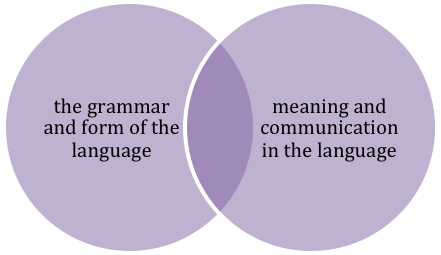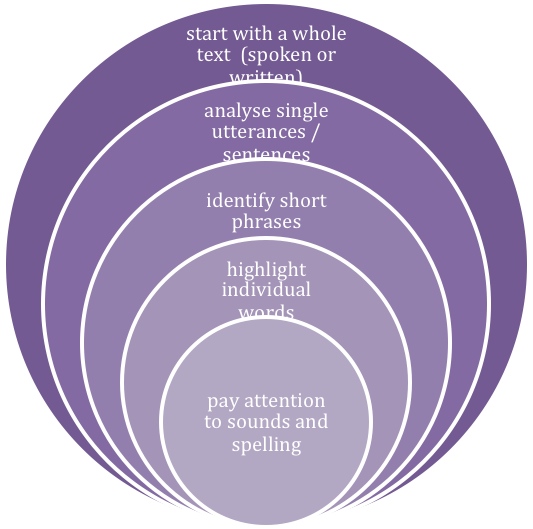

The following sentences all mean, the echidna will eat the ants. Although the word order changes, all of the sentences are grammatically correct. Changing their position just changes the emphasis.
bigibila echidna buurrngan ant dha-li eat-WILL -gu ACTOR suffix
Bigibila-gu buurrngan dha-li.Sometimes teachers explicitly explain differences such as these to students (especially older students) so that they can develop skills to analyse the structure of the language. Often these explanations are given to the students in English. That is, the teacher talks to the students in English about the language.
Bigibila-gu dha-li buurrngan.
Buurrngan bigibila-gu dha-li.
Buurrngan dha-li bigibila-gu.
Dha-li bigibila-gu buurrngan.
Dha-li buurrngan bigibila-gu.
Widyunggalu-ndhu wi-gi?Effective language teaching leads students to use their knowledge of the form of the language to develop skills for talking and listening to each other, reading and writing to each other. Language teaching includes both grammar and people interacting in meaningful ways. It is a balance between correct grammar and using language to communicate. Keeping in mind language functions and purposes (such as the ones above) is one a way to ensure your teaching program includes communicating in the language.
How are you going to live?
Gariya yaambul yala. Dhulubul ya-la.
Do not tell lies. Speak the truth.
Ya-l-mambi-ya mayiny-galang. Marun-bunmi-la-dha.
Teach the people. Love each other.
Marraga-la-dha. Walan-ma-ya mayiny-galang.
Hold together and empower the people.
Marun-bunmi-ya mayiny-guwal-bang-gu.
Be kind and gracious to strangers.
Winhanga-gi-gila-dha. Ngu-ng-gi-la-dha.
Care for each other. Share with each other.
Yindyama-la Mayiny-galang-gu.
Give honour and respect to all people.
Bangga-ya-la.
Cause quarrelling to stop.
Gulbala-dha murraya-la marrum-bang-gu.
Speak up for justice and peace without fighting.
Nga-nga-dha garray-gu bila galang-gu.
Look after the land and the rivers.
Yandhu garray-bu bila-galang-bu nga-nga-girri nginyalgir.
Then the land and the rivers will look after you all.


The boy is at the river.While English has prepositions at, for and with, those meanings would be expressed in Australian languages in suffixes added to the nouns (river, cousin, black bream and line). When teachers highlight patterns such as these, students can understand and begin to use the grammatical structures in the language they are learning. The set of sentences above could be an oral language game (with students sitting in a circle and adding to the length of the sentence) or designed as a reading and writing activity in a teacher-made worksheet or interactive white board exercise. Language teachers are mindful of their approach to teaching grammar.
The boy is at the river fishing.
The boy is at the river fishing with his cousin.
The boy is at the river fishing with his cousin for black bream.
The boy is at the river fishing with his cousin for black bream with a line.
Student A: Yaama dhaadhaa. How are you grandfather?Grammar can be taught through songs which repeat a language structure over and over, e.g. the Dhaga wambuwuny song below in teaches locative suffix patterns in Wiradjuri. It is from the Wiradjuri language songs book created by Stan Grant Senior and John Rudder:
Student B: Gaba birray, nginda? Good boy, and you?
Student A: Gababula. Minyanda gimbildanha? Good too. What are you doing?
Student B: Yinabildanha ngaya. I am fishing.
Student A: Minyaaya baagii? Where is grandmother?
Student B: Wii wiimaldanha nguu. She is making a fire.
Student A: Minyaaya walgan ngay? Where is my aunt?
Student B: Dhuwarr yilamaldanha nguu. She is cooking bread.
Student A: Minyaaya wambanhiya ngay? Where is my cousin?
Student B: Gaawaaga gubiylanha nguu. He is swimming in the river.
Student A: Minyaaya baawaa ngay? Where is my sister?
Student B: Wii nguu dhiyamaldanha. She’s collecting wood.
Student A: Minyaaya garruu? Where is uncle?
Student B: Dhaldanha nguu. He is eating.
Student A: Minyaaya dhagaan ngay? Where is my brother?
Student B: Giirr dhanduwiylanha nguu, ngarragaa birray. He is sleeping, hopeless boy!
Student A: Yanaawaanha ngaya gundhigu. I am going home.
Student B: Ngaayaybaay birray, gaba yanaaya. Okay boy, go well.
Student A: Baayandhu ngarralay ngali. Bye.
Running dictation can be a fun way to teach grammar. The teacher chooses a short passage and pins just one copy up on the wall at the front of the classroom. The class is divided into teams of 3-4 students. The first student in each group runs to the passage, memorises the first sentence, runs back and dictates it to the scribe in their group. A student may need to run back and check if s/he hasn’t been able to remember the whole sentence. The second student in each group runs to, memorises, runs back and dictates the second sentence; and so on until each group has completed the passage. The teacher then gives each group a copy of the passage so that they can compare how accurately they have written it down. The repetition in this activity gives the students an opportunity to revise the vocabulary and structures they are learning.
Where is kangaroo?
Where is kangaroo?
In the grass. In the grass.
Kangaroo’s in the grass.Dhaga wambuwuny?
Dhaga wambuwuny?
Buguwinydya. Buguwinydya.
Wambuwuny buguwinydya.Where is koala?
Where is koala?
In the tree. In the tree.
Koala’s in the tree.
Dhaga barrandung?
Dhaga barrandung?
Madhandha. Madhandha.
Barrandung madhadha.Where is emu?
Where is emu?
At the nest. At the nest.
Emu’s at the nest.Dhaga dhinawan?
Dhaga dhinawan?
Ngurangga. Ngurangga.
Dhinawan ngurangga.Where is platypus?
Where is platypus?
In the water. In the water.
Platypus is in the water.Dhaga biladurang?
Dhaga biladurang?
Galingga. Galingga.
Biladurang galingga.
Providing information
about good teaching for reviving Australian languages is one of
the main purposes of this website. To make it more accessible we
have arranged it under the following headings: